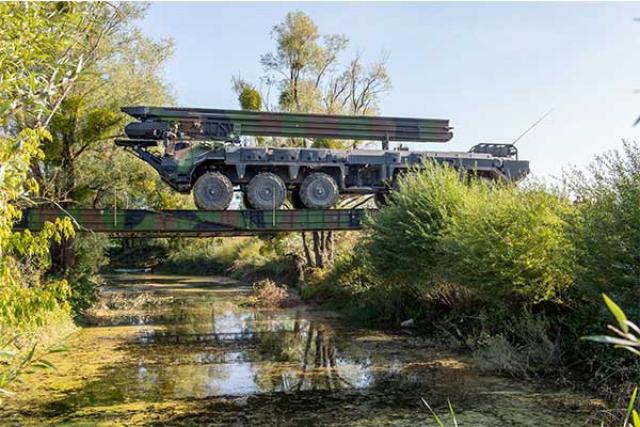
Enhanced operational performance for French Army’s SPRAT bridging systems
Key figures
deployment time
all-round vision
MLC – long bridge
The SPRAT rapid bridge installation system is a tactical solution for the projection of ground force units that is used to cross ravines and waterways.
Designed by CNIM Systèmes Industriels in the 1990s, ten SPRAT systems are currently used by the French Army.
SPRAT, which has been in service with the French Army since 2013, is a true digital combat system enabling the crossing of dry and wet gaps up to 25 m wide for forward tactical vehicles,
says Major Quentin, in charge of the SPRAT system’s assessment.
The system comprises a bridging vehicle (carrying two bridging elements) and an additional bridge-element carrier (for two bridging elements). The bridging vehicle is operated by a team of two sappers in the cab, with protection against nuclear and chemical threats. Automation allows installation in less than 10 minutes and withdrawal just as quickly.
Equipped with 10x10 transmission and steering providing remarkable mobility, the SPRAT is in no way penalized by its impressive size and can accompany leading combat troops,
explains Major Quentin.
Facing the two-fold challenge of the obsolescence of military equipment, including SPRAT, and the changing operational needs of military forces, DGA (the French Defense Procurement Agency) awarded CNIM a contract for the modernization of SPRAT systems.
Under this contract, CNIM will modernize the entire fleet in 2019 and optimize its maintenance in operational condition throughout its service life, notably by modernizing its equipment.
Major Quentin adds:
The present modernization of the bridging vehicle will improve the management of any technical failures by means of a simplified instrumentation and control system (ICS) and a brand new, 360° day-and-night optronic vision system that is indispensable for the crew to ensure safe operation in all circumstances.
PTA modular assault bridge, the ideal solution for tactical vehicle crossings

THE tactical bridging system for ground forces
SPRAT provides indispensable support for leading combat vehicles (such as VBCI armored infantry combat or Scorpion vehicles and Leclerc tanks).
Comprising two vehicles (a five-axle carrier and additional bridge element carriers), the SPRAT system can adapt the length of the bridge to the breadth of the obstacle to be crossed:
- either two short 14-meter bridges, MLC 100T/150W,
- or one long 26-meter bridge, MLC 85T/120W, obtained by assembling two bridge elements.

A logistic edge for external military operations
This modular capability that is unique in the world incorporates a bridge launching and recovery system providing significant savings in terms of resources.
The automated deployment system can install a bridge in 10 minutes, requiring just two personnel.

Excellent maneuverability characteristics
With its 10-wheeled chassis, SPRAT is compatible with the speed of military armored vehicles:
- 70 km/h
- Maneuverable on all terrains (snow, sand and road)
- Range of 800 km
Fitted with stabilizing legs, the SPRAT can establish bridges from unprepared banks
- inclination of +/-5%
- slope of +/- 10%
Modernizing ground force projection capabilities
This modernization program includes two major improvements:
- a supervisory instrumentation and control system
- a latest-generation optronic vision system
Enhancing mobility support systems
The onboard supervisory instrumentation and control system (or central computing system) is to be fully modernized. The new IT architecture adopted will control all the SPRAT technical parameters.
- A single ICS computer instead of two, plus one dedicated optronic computer
- Simpler interface but with the same hardware architecture ensuring the interchangeability of parts
Boosting logistic performance
CNIM Systèmes Industriels has equipped SPRAT with a latest-generation optronic vision system developed by Bertin Technologies.
This technology provides SPRAT with 360° all-round vision by day and by night (night level 3), optimizing the ability to detect external threats during haulage and bridging operations.
- Seven cameras instead of four previously.
The new ICS and Optronic architecture also facilitates the measurement of gaps in order to drop the bridge onto the far bank).
- A single sighting operation is required instead of two as previously.
Ensuring maintenance in operational condition
In response to operational requirements, CNIM Systèmes Industriels provides the French Army with the assurance that SPRAT systems and their equipment will be maintained in operational condition throughout their service life.
Four CNIM Systèmes Industriels maintenance operators qualified for work on SPRAT and other vehicles (Buffalo, Souvim, etc.) are based at the French Army’s 13th Engineers Regiment military camp in Valdahon with occasional missions in Mourmelon to provide:
- quick response capabilities on military sites for troubleshooting and support tasks
- a hot-line service facilitating remote repair services
- management of State stock with responsive procurement on military sites
- scheduled preventive and remedial measures
- processing technical data feedback from users
- maintenance of tool sets and statutory follow-up of equipment integrated in bridging vehicles
- training of teams, on simulator and by computer-assisted training techniques

Deployment for external operations

Tactical capabilities tested in operational conditions
SPRAT ensures personnel safety:
- Digital combat system (IR camera, operator interface, telemetry, etc.)
- Armored cab resistant to CBRN threats

SPRAT bridging elements: outstanding performances
Complying with NATO standards and the FINABEL Convention, SPRAT is compatible with all allied vehicles.
Thanks to its system of deployment based on translational motion and the modular capability of its bridging elements, this extremely robust bridge can be mounted on wheeled or tracked chassis.